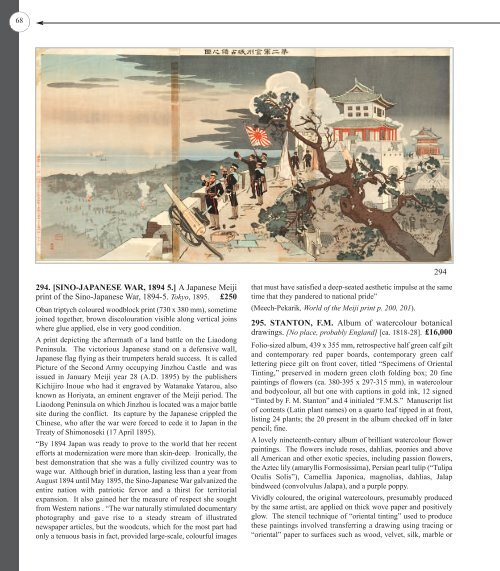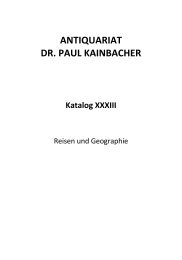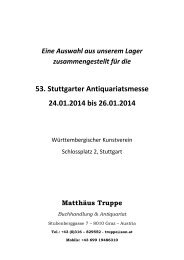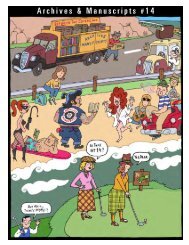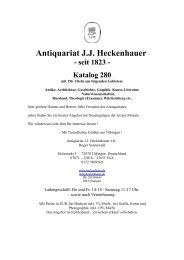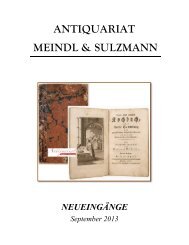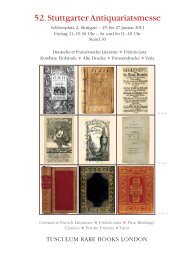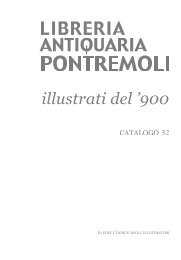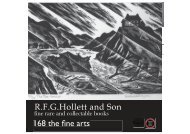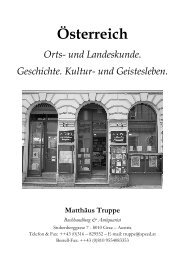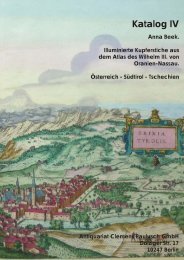Japanese Prints
Japanese Prints
Japanese Prints
You also want an ePaper? Increase the reach of your titles
YUMPU automatically turns print PDFs into web optimized ePapers that Google loves.
68<br />
294<br />
294. [SINO-JAPANESE WAR, 1894 5.] A <strong>Japanese</strong> Meiji<br />
print of the Sino-<strong>Japanese</strong> War, 1894-5. Tokyo, 1895. £250<br />
Oban triptych coloured woodblock print (730 x 380 mm), sometime<br />
joined together, brown discolouration visible along vertical joins<br />
where glue applied, else in very good condition.<br />
A print depicting the aftermath of a land battle on the Liaodong<br />
peninsula. The victorious <strong>Japanese</strong> stand on a defensive wall,<br />
<strong>Japanese</strong> flag flying as their trumpeters herald success. It is called<br />
picture of the Second Army occupying Jinzhou castle and was<br />
issued in January Meiji year 28 (A.d. 1895) by the publishers<br />
Kichijiro Inoue who had it engraved by Watanake Yatarou, also<br />
known as Horiyata, an eminent engraver of the Meiji period. The<br />
Liaodong peninsula on which Jinzhou is located was a major battle<br />
site during the conflict. Its capture by the <strong>Japanese</strong> crippled the<br />
chinese, who after the war were forced to cede it to Japan in the<br />
Treaty of Shimonoseki (17 April 1895).<br />
“By 1894 Japan was ready to prove to the world that her recent<br />
efforts at modernization were more than skin-deep. Ironically, the<br />
best demonstration that she was a fully civilized country was to<br />
wage war. Although brief in duration, lasting less than a year from<br />
August 1894 until May 1895, the Sino-<strong>Japanese</strong> War galvanized the<br />
entire nation with patriotic fervor and a thirst for territorial<br />
expansion. It also gained her the measure of respect she sought<br />
from Western nations . “The war naturally stimulated documentary<br />
photography and gave rise to a steady stream of illustrated<br />
newspaper articles, but the woodcuts, which for the most part had<br />
only a tenuous basis in fact, provided large-scale, colourful images<br />
that must have satisfied a deep-seated aesthetic impulse at the same<br />
time that they pandered to national pride”<br />
(Meech-pekarik, World of the Meiji print p. 200, 201).<br />
295. STANTON, F.M. Album of watercolour botanical<br />
drawings. [No place, probably england] [ca. 1818-28]. £16,000<br />
folio-sized album, 439 x 355 mm, retrospective half green calf gilt<br />
and contemporary red paper boards, contemporary green calf<br />
lettering piece gilt on front cover, titled “Specimens of Oriental<br />
Tinting,” preserved in modern green cloth folding box; 20 fine<br />
paintings of flowers (ca. 380-395 x 297-315 mm), in watercolour<br />
and bodycolour, all but one with captions in gold ink, 12 signed<br />
“Tinted by f. M. Stanton” and 4 initialed “f.M.S.” Manuscript list<br />
of contents (Latin plant names) on a quarto leaf tipped in at front,<br />
listing 24 plants; the 20 present in the album checked off in later<br />
pencil; fine.<br />
A lovely nineteenth-century album of brilliant watercolour flower<br />
paintings. The flowers include roses, dahlias, peonies and above<br />
all American and other exotic species, including passion flowers,<br />
the Aztec lily (amaryllis formosissima), persian pearl tulip (“Tulipa<br />
Oculis Solis”), camellia Japonica, magnolias, dahlias, Jalap<br />
bindweed (convolvulus Jalapa), and a purple poppy.<br />
Vividly coloured, the original watercolours, presumably produced<br />
by the same artist, are applied on thick wove paper and positively<br />
glow. The stencil technique of “oriental tinting” used to produce<br />
these paintings involved transferring a drawing using tracing or<br />
“oriental” paper to surfaces such as wood, velvet, silk, marble or


